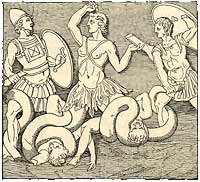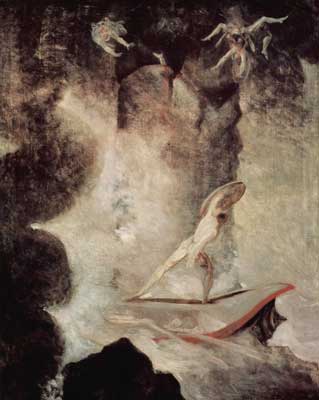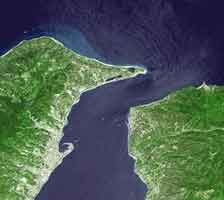.

In Greek mythology, Charybdis or Kharybdis (Greek Χάρυβδις) was a sea monster, daughter of Poseidon and Gaia. She takes form as a monstrous mouth. She swallows huge amounts of water three times a day and then belches them back out again creating whirlpools. Charybdis was originally a naiad, sea-nymph who flooded land to enlarge her father's underwater kingdom, until Zeus turned her into a monster. He was angry that she was taking so much of his land and made it so that she would be incredibly thirsty three times a day and suck in the water.
The myth has Charybdis lying on one side of a narrow channel of water. On the other side of the strait was Scylla, another sea-monster. The two sides of the strait are within an arrow's range of each other, so close that sailors attempting to avoid Charybdis will pass too close to Scylla and vice versa. The phrase between Scylla and Charybdis has come to mean being in a state where one is between two dangers and moving away from one will cause you to be in danger of the other. Between Scylla and Charybdis is the origin of the phrase "between the rock and the whirlpool" (the rock upon which Scylla dwelt and the whirlpool of Charybdis) and may be the genesis of the phrase "between a rock and a hard place".

Odysseus between Scyla and Charybdis, Johann Heinrich Füssli, 1794-1796
On the other side of the strait was Scylla, another sea-monster. The two sides of the strait are within an arrow's range of each other, so close that sailors attempting to avoid Charybdis will pass too close to Scylla and vice versa. The phrase between Scylla and Charybdis has come to mean being in a state where one is between two dangers and moving away from one will cause you to be in danger from the other.
The Argonauts were able to avoid both dangers because they were guided by Thetis, one of the Nereids. Odysseus was not so fortunate; he chose to risk Scylla at the cost of some of his crew rather than lose the whole ship to Charybdis. (Homer's Odyssey, Book XII).
Traditionally, the location of Charybdis has been associated with the Strait of Messina off the coast of Sicily, opposite the rock called Scylla. The whirlpool there is caused by the meeting of currents, but is seldom dangerous. Recently scholars have looked again at the location and suggested this association was a misidentification and that a more likely origin for the story could be found near Cape Skilla in north west Greece.

Satellite photo of the Strait of Messina, taken June 2002. Image courtesy of NASA. The Strait of Messina is the narrow section of water between the eastern tip of Sicily and the southern tip of Italy. A natural whirlpool forms there, which has been inaccurately linked to the legend of Charybdis.
The Police use the Scylla and Charybdis reference in their song, Wrapped Around Your Finger.
See also : Greek Mythology. Paintings, Drawings
| Ancient Greece
Science, Technology , Medicine , Warfare, , Biographies , Life , Cities/Places/Maps , Arts , Literature , Philosophy ,Olympics, Mythology , History , Images Medieval Greece / Byzantine Empire Science, Technology, Arts, , Warfare , Literature, Biographies, Icons, History Modern Greece Cities, Islands, Regions, Fauna/Flora ,Biographies , History , Warfare, Science/Technology, Literature, Music , Arts , Film/Actors , Sport , Fashion --- |
Retrieved from "http://en.wikipedia.org"
All text is available under the terms of the GNU Free Documentation License

